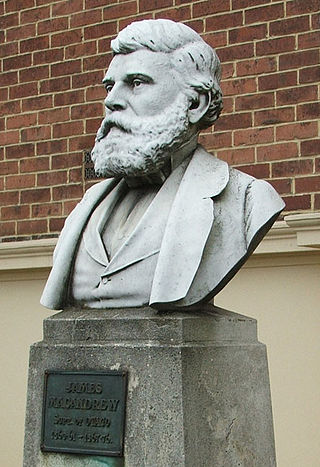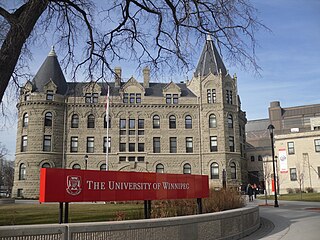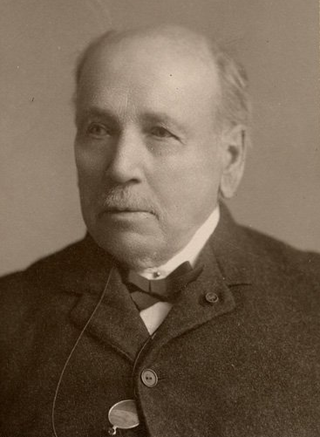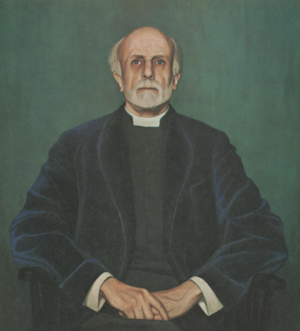Methodism, also called the Methodist movement, is a group of historically related denominations of Protestant Christianity whose origins, doctrine and practice derive from the life and teachings of John Wesley. George Whitefield and John's brother Charles Wesley were also significant early leaders in the movement. They were named Methodists for "the methodical way in which they carried out their Christian faith". Methodism originated as a revival movement in the Church of England in the 18th century and became a separate denomination after Wesley's death. The movement spread throughout the British Empire, the United States, and beyond because of vigorous missionary work, and today has about 80 million adherents worldwide.

The Free Church of Scotland is a Scottish denomination which was formed in 1843 by a large withdrawal from the established Church of Scotland in a schism known as the Disruption of 1843. In 1900, the vast majority of the Free Church of Scotland joined with the United Presbyterian Church of Scotland to form the United Free Church of Scotland. In 1904, the House of Lords judged that the constitutional minority that did not enter the 1900 union were entitled to the whole of the church's patrimony, the Free Church of Scotland acquiesced in the division of those assets, between itself and those who had entered the union, by a Royal Commission in 1905. Despite the late founding date, Free Church of Scotland leadership claims an unbroken succession of leaders going all the way back to the Apostles.

William Collins was a Scottish schoolmaster, editor and publisher who founded William Collins, Sons, now part of HarperCollins. William Collins was born at Eastwood, Renfrewshire, on 12 October 1789. He was a millworker who established a company in 1819 for printing and publishing. The business eventually published pamphlets, sermons, hymn books and prayer books as well as a wide range of office products. By 1824 he had produced the company's first dictionary, the Greek and English Lexicon. He was instrumental in bringing Thomas Chalmers from Kilmany to Glasgow. He also obtained a licence to publish the Bible in the 1840s. He was promoter of Scotland's first temperance movement. He founded the Glasgow Church Building Society which created 20 new churches. He died on 2 January 1853 at Rothesay, Buteshire.

James Macandrew was a New Zealand ship-owner and politician. He served as a Member of Parliament from 1853 to 1887 and as the last Superintendent of Otago Province.

Joseph Reed, a Cornishman by birth, was a prolific and influential Victorian era architect in Melbourne, Australia. He established his practice in 1853, which through various partnerships and name changes, continues today as Bates Smart, one of the oldest firms continually operating in Australia.

The Presbyterian Church in Canada is a Presbyterian denomination, serving in Canada under this name since 1875. The United Church of Canada claimed the right to the name from 1925 to 1939. According to the Canada 2001 Census 409,830 Canadians identify themselves as Presbyterian, that is, 1.4 percent of the population.

Knox Presbyterian Church is a Presbyterian Church in Ottawa, Ontario, Canada. It is named after John Knox, a founder of Presbyterianism in Scotland.

Saint James United Church is a heritage church in the city's downtown core of Montreal, Quebec, Canada. It is a Protestant church affiliated with the United Church of Canada. It is located at 463 Saint Catherine Street West between Saint Alexandre and City Councillors Streets, in the borough of Ville-Marie within Downtown Montreal. It was designated as a National Historic Site of Canada in 1996.

Wesley College was a college that existed in Winnipeg, Manitoba, Canada, from 1888 to 1938. In 1924, Wesley College became part of the United Church of Canada. It was one of the University of Winnipeg's founding colleges.

Charles Baillairgé was an architect, land surveyor, civil engineer, and an author.
Bates Smart is an architectural firm with studios in Melbourne and Sydney, Australia. Founded in 1853 by Joseph Reed, it is known as one of Australia's oldest architectural firms. Over the decades, the firm's multidisciplinary practices involving architecture, interior design, urban design, strategy, sustainability and research, have been responsible for some of Australia’s most well-known and loved buildings.

HMCS Cap de la Madeleine was a River-class frigate that served in the Royal Canadian Navy from 1944-1945 and as a Prestonian-class frigate from 1954-1965. She saw action in the Battle of the Atlantic as a convoy escort during the Second World War. She is named for Cap-de-la-Madeleine, Quebec, which is now a part of Trois-Rivières.

HMCS Magog was a River-class frigate that served in the Royal Canadian Navy (RCN) during the Second World War. She was used primarily as a convoy escort. On 14 October 1944, she was torpedoed by U-1223. She survived the attack, was towed to port and declared a constructive total loss. Magog was named for the town of Magog, Quebec.
Hazen Aldrich was an early leader in the Latter Day Saint movement. After the death of Joseph Smith, Aldrich went on to lead a small denomination of Latter Day Saints known as the Brewsterites.

The Jerry Rescue occurred on October 1, 1851, and involved the public rescue of a fugitive slave who had been arrested the same day in Syracuse, New York, during the anti-slavery Liberty Party's state convention. The escaped slave was William Henry, a 40-year-old cooper from Missouri who called himself "Jerry."

William M. Hossak was a Canadian politician, serving as Mayor of Quebec City from November 1869 to January 1870.

Salem Goldworth Bland was a Canadian Methodist theologian, Georgist, and one of Canada's most important Social Gospel thinkers.
William Reed was a Canadian organist, choir conductor, and composer. He held numerous organ and choirmaster posts in churches throughout Canada from 1884 until 1913. His career in this area was cut short as his deafness worsened. He spent the remainder of his career composing and contributing articles to music periodicals like The Etude. His compositional output mainly consists of sacred works, including many anthems and works for solo organ. His more well known works include the Christmas cantata The Message of the Angels (1910), the cantata The Burden of the Cross (1912), the Easter cantata The Resurrection and the Life (1911), and the Grand Choeur in D for organ (1901). His pupil Henri Gagnon considered the latter work "one of the very best Canadian compositions".

Vieux-Québec–Cap-Blanc–Colline Parlementaire is one of the 35 districts of the City of Quebec, and one of six that are located in the borough of La Cité-Limoilou. The district is the most visited and toured location in the city. It is in this partly fortified area where the Château Frontenac is found, with its large terrace overlooking the city of Lévis, across the Saint Lawrence River. A large concentration of cafes, tourist shops, restaurants, hotels and inns are situated in the district. In its most recent census count in 2016, Statistics Canada reported that the district had a population of 5,770 residents, whom comprise 1.1% of the city's total population.

John Wells (1789–1864), was an English-born architect who had his works displayed at the Royal Academy in the 1820s. He is best known for his work in Montreal, Quebec, most notably the Bank of Montreal Head Office and St. Anne's Market, that afterwards housed the Parliament Buildings at Montreal.

















